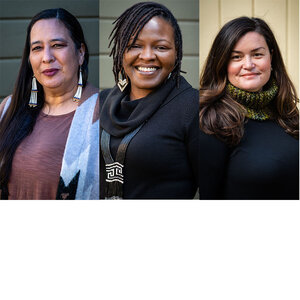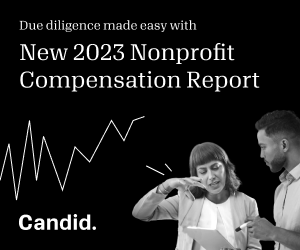To lead our organization into justice work, we must lead it together

The history of the first March on Washington for Jobs and Freedom 60 years ago is often distilled into the story of one man, Rev. Martin Luther King, Jr. and his “I Have a Dream” speech. But the steps of the Lincoln Memorial were overflowing that day with a multitude of leaders who were critical to that moment and its broader, multiracial, intergenerational, and transpolitical movement of activists, allies, and accomplices.
One of the enduring lessons of the Civil Rights era is that leadership enables progress, but co-leadership enables transformation. The March on Washington was orchestrated by the strategies, voices, and investments of people of all genders, in Black bodies and white bodies and queer bodies, religious people and spiritual “nones,” and voters across political lines—all of whom knew that bending the moral arc of the universe toward justice required pulling from all angles. People whose names we may never know, and many we rarely recall, practiced a form of leadership that saw justice work as communal work: Dorothy Height, Daisy Bates, Anna Arnold Hedgeman, Bayard Rustin, A. Philip Randolph, Whitney Young, Walter Reuther, Mathew Ahmann, and Rabbi Joachim Prinz.
Across successful social movements of the last century, it was common to see co-leadership: for example, Dolores Huerta and César Chávez organizing to protect farmworkers, Anne Braden and Ella Baker advocating for civil liberties alongside civil rights, and Huey Newton and Elaine Brown building Black power.
But by the time the two of us—a Black man and a white man now in our 30s and early 40s—entered the social sector, the prevailing archetype for nonprofit leadership was a do-gooder version of the tech bro: a singular, strong and smart (both subjectively defined), data-driven, and charismatic “social entrepreneur.” Philanthropic fortunes were amassed and empires were built so “solutions” could be scaled, but by and large, the underlying conditions of systemic racism, structural poverties, and intersecting, generational traumas remained unaddressed.
We know this journey at FoodCorps because we lived it. Over our first decade, under Curt’s leadership as sole CEO, we grew from an idea to a $20 million budget, replicating our AmeriCorps direct service program across 17 states as we worked to connect kids to healthy food in school. By many measures—external evaluations, students served, fruits and vegetables consumed, funders attracted—we were succeeding...until, like many of our peer organizations, we ran headlong into the limitations and harms of our approach. At an all-staff retreat in 2019, FoodCorps broke open. We experienced the necessary disruption many white-founded, white-dominated social venture organizations later saw in the reckoning following George Floyd’s murder. Despite good intentions and commitments to diversity, equity, and impact, we weren’t operating as a just organization internally, as our colleagues of color painfully pointed out. In a majority of the schools and communities facing the compounding hardships of being seen, heard, and experienced as human in this nation, the gardening and cooking lessons we were teaching were doing little to improve the broken systems of food and education.
So, with the support of funders who stayed with us and staff who committed to both individual and collective learning and unlearning, FoodCorps entered an intense period of introspection and reinvention. We have emerged as a far different—and far more effective—organization. We’re far more ambitious now, too.
A year ago, at the first White House Conference on Hunger, Nutrition, and Health since the 1960s, FoodCorps announced an audacious goal: By 2030, all 50 million public school students will have access to food education and free, nourishing meals in school. This objective only feels attainable to us after our period of reinvention, and under two additional conditions: First, that we stamp our identity in the world as a justice organization—one that seeks change not solely by scaling our programs but by building power, mobilizing a movement, and changing policies and systems that for too long have perpetuated injustice. Second, that we move beyond the cult of the heroic social entrepreneur and into a future where we grapple—on both personal and public levels—with the daily work of building the kind of multiracial, intergenerational, transpolitical coalition that none of us can galvanize alone.
In codifying our work as justice work, we are rooting our mission in a call for systemic and structural change. FoodCorps is reorienting our work to amplify the voices of kids, families, caregivers, and BIPOC school nutrition professionals, and to advance legislation that reflects their vision for the future of food in school. In states like California, Maine, and New Mexico, we have helped make school meals free for every child.
In transitioning to shared leadership, we are taking inspiration from the justice movements that came before us, bringing together two humans from varied walks of life—food and education, Black and white, coastal and midwestern, queer and ally; and thus, differing histories with democracy—to face each other, tell our truths, and co-lead a vision for impact. Beyond strengthening our mission, this gives us a chance to grapple with the structural failings that make our nonprofit—every nonprofit—necessary in the first place.
FoodCorps is just one of many organizations relearning co-leadership as the way forward. Side by Side, Asian-Pacific Environmental Network, GirlTrek, and Schmidt Futures are all leveraging partnership-based approaches.
So, what are the lessons we are learning about the conditions or practices that make co-leadership successful and powerful?
1. Look beyond what the organization needs—and ask what the movement needs. Many nonprofits that have transitioned to shared leadership models have done so with a focus on the skills (especially equity leadership) and identities (especially BIPOC) previously missing. While filling these gaps is meaningful, and doing so was part of FoodCorps’ initial rationale for co-leadership, diversity is only a starting point. The larger transformation needed is to shift the focus from growing our organizations to fulfilling our missions. Thus the questions for co-leaders are: What systems do you deeply understand? With whom are you readily in coalition? What could your public voice unlock for this cause?
2. Create the conditions for co-leadership to succeed before the co-leader arrives. Too often, nonprofits jump to alternative leadership structures as a first step in reorienting a historically white organization around values and practices of diversity, equity, inclusion, and justice. Assigning the exhausting project of repair to a new leader, and one who likely shares some of the identities that have been marginalized by your previous practice, is hardly an act of justice. Although FoodCorps had made significant strides in the creation and implementation of our Just FoodCorps framework prior to Rob’s arrival, the amount of internal change he still needed to catalyze as a new co-leader with unique insights was significant, and always will be.
3. Recognize that co-leadership is a commitment not just to working on mission, but also to working on yourself. Far too often, leaders of color are forced to conform into postures of hyper-performance and unflappability, relying on resilience—which can be rooted as a trauma-response to norms, practices, and embodiments in historically white organizations. White leaders, on the other hand, can feel they are contorting themselves into stances of niceness, shying away from critical conversations—borne of the fears and anxieties of being “called out.” For both of us, therapy, coaching, accountability partners (within and beyond the organization), and grappling with our life experiences and unexamined assumptions has been essential to our partnership. By coming to know each other’s humanity more fully, we have been able to meet the inherent conflicts and questionings that come from co-leadership with empathy and curiosity.
Against the national backdrop of injustices, plights, and political discord we are living in, the resurgence of co-leadership models across the social sector is a hopeful sign. It recalls the intercultural and intersectional leadership that was the drumbeat of progress in the 20th century. It invites us to let go of heroism and saviorism, and to root ourselves in the health and sustainability of our missions and movements, not just our individual organizations. It roots us in a seven-generation posture that takes seriously its responsibility to those not yet born—as much as its gratitude for those who have journeyed already.
Dr. Robert S. Harvey and Curt Ellis are co-CEOs of FoodCorps.








How to power shift in philanthropy: Lessons from The Share Fund’s radical approach to participatory grantmaking